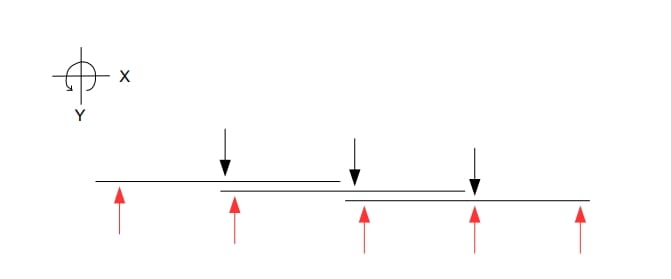I’m a welding tech, so this problem is beyond me.
I’d also like to put this into Excel so I can set different variables and decide how much something can weigh or change the length, etc.
A three-stage telescopic tube is suspended from a total of five mounting points. The tubes are guided by rollers on the inside and outside. The weight of the inner tubes is also transferred to the next outer tube via the rollers.
We need the maximum weight that can be achieved per attachment point. The added total weight will be higher than the complete weight of the entire telescopic tube, as the weights shift depending on the position.
Weight of tube A = 445Kg
Weight of tube B = 575Kg
Weight of tube C = 745 kg
Feel free to ignore the numbers, I’d like to just figure out how to calculate this with symbols for now.
Thanks in advance! I’m just trying to learn something new. This isn’t from a course, I’m just trying to figure out how to solve a manufacturing problem, I’m not sure I have enough info.
 |
|
[URL unfurl="true"]https://res.cloudinary.com/engineering-com/image/upload/v1721324559/tips/IMG_4375_zdveih.jpg[/URL]|
[URL unfurl="true"]https://res.cloudinary.com/engineering-com/image/upload/v1721324559/tips/IMG_4376_ny34ui.jpg[/URL]
I’d also like to put this into Excel so I can set different variables and decide how much something can weigh or change the length, etc.
A three-stage telescopic tube is suspended from a total of five mounting points. The tubes are guided by rollers on the inside and outside. The weight of the inner tubes is also transferred to the next outer tube via the rollers.
We need the maximum weight that can be achieved per attachment point. The added total weight will be higher than the complete weight of the entire telescopic tube, as the weights shift depending on the position.
Weight of tube A = 445Kg
Weight of tube B = 575Kg
Weight of tube C = 745 kg
Feel free to ignore the numbers, I’d like to just figure out how to calculate this with symbols for now.
Thanks in advance! I’m just trying to learn something new. This isn’t from a course, I’m just trying to figure out how to solve a manufacturing problem, I’m not sure I have enough info.

[URL unfurl="true"]https://res.cloudinary.com/engineering-com/image/upload/v1721324559/tips/IMG_4375_zdveih.jpg[/URL]|
[URL unfurl="true"]https://res.cloudinary.com/engineering-com/image/upload/v1721324559/tips/IMG_4376_ny34ui.jpg[/URL]

